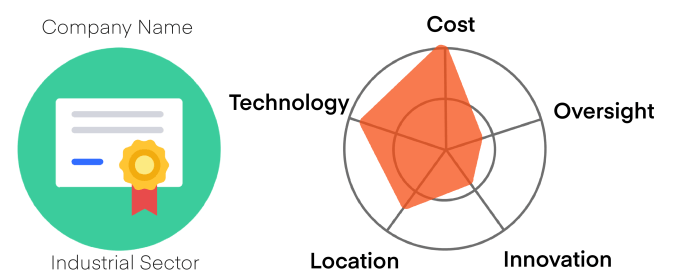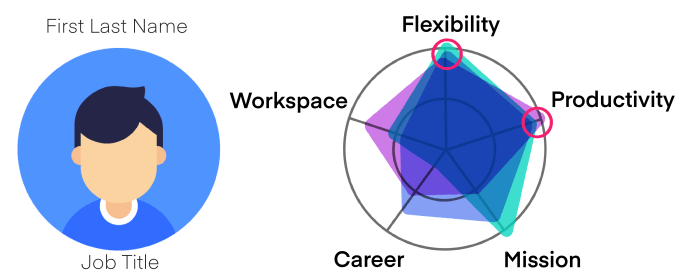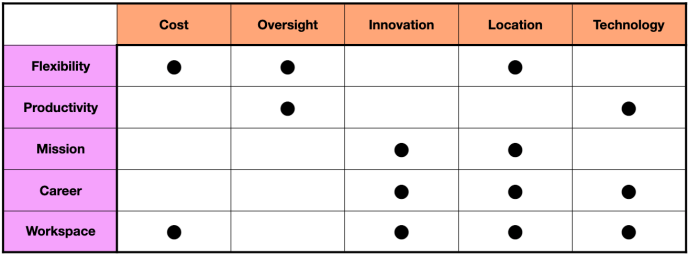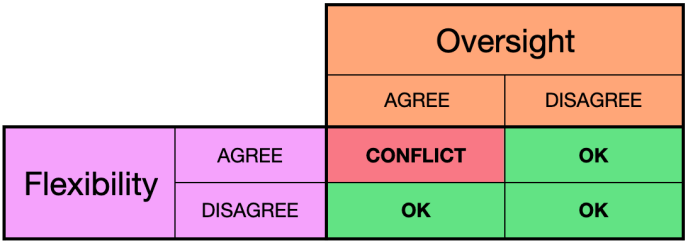
Aligning Employee and Employer for Telework
Our thesis is that after the pandemic telework will become a permanent corporate practice across industries rather than the emergency measure it is today. Many industries, including transportation, travel and hospitality, retail, education, and even manufacturing and healthcare, will broadly adopt telework. The post-pandemic adoption will be based on corporate considerations (e.g., cost reduction from real estate savings), and employee objectives (e.g., employees relocating to lower-cost cities). To broadly and successfully employ telework we must understand these considerations and objectives that employers and employees want to achieve and the dimensions they will use to assess progress and ultimate attainment. On some of these dimensions employers and employees may be aligned, and on some may not. In this post, we introduce such dimensions and present an approach for identifying misalignment.
This is the third piece of my collaboration with Nikos Michalakis, VP, Software Platform at Woven Planet Holdings and it also appears on his Red Vest Mindset site.
The telework dimensions
In the previous post of this series, we presented a framework for creating telework-centric processes. While telework may be important to both employers and employees, each group has different considerations and objectives while pursuing it. For example, an employer, such as a vocational school, may pursue telework by offering only online classes, to reduce real estate costs, extend its market reach, and attract faculty from different parts of the country. On the other hand, the instructor/employee of such a school may prefer telework to be able to work remotely from home at a low-cost location for a school with an inspiring mission. These considerations can be expressed in terms of a set of Telework Dimensions.
Through our research with corporate executives we have identified the following Employer Telework Dimensions that are used to assess whether to adopt telework:
- Cost Reduction. Many of the interviewed executives consider telework as a way to significantly reduce real estate costs but also other costs that they associate with employee retention, e.g., office meals. Certainly, such savings will need to be compared to the cost of creating telework-centric processes, training the employees that will be used in such processes, equipping them with the appropriate technologies to enable them to perform these processes, and potentially retraining and/or providing severance payments to the employees that will be displaced because of the adoption of telework. While this was the most frequently articulated dimension, it requires additional analysis.
- Employee Efficiency and Oversight. Employers view telework as an opportunity for increased efficiencies but want to assess its impact on the reduced employee oversight telework entails. In certain industries, close employee oversight is considered very important. For example, it is considered important when production throughput with low error rates is necessary. This is the case with automotive assembly lines. Employers associate telework with reduced ability to closely monitor employee activities and are concerned about their efficiency and productivity.
- Innovation. Serendipitous discoveries that are often the result of opportunistic brainstorming sessions among a team’s members are an essential characteristic of every disruptive or sustaining innovation process. Because of the distance it unavoidably introduces among team members, employers are concerned that telework may emerge as a serious obstacle to innovation.
- Talent Acquisition and Retention. Organizations used to prefer large campuses where they could achieve economies of scale, have closer employee oversight, and even facilitate innovation. Consider the campuses of companies like IBM, GM, Google, Foxconn, and many others. While concerned about the impact on innovation, and because of the war for talent, employers are considering how the ability to telework can help with the retention of existing highly-valued employees, as well as the recruitment of new, high-caliber ones.
- Technology Advantage. The accelerating adoption of technologies that are required by telework-centric processes, such as digital twins, intelligent collaboration applications, and autonomous systems, can provide important productivity and cost advantages to the organizations that utilize them. Employers want to assess how well these technologies enable them to re-imagine processes that were previously bound by physical space, such as a factory floor, or a hospital’s operating room.
Employees use a different set of dimensions to assess whether they want to remain in or become members of, an organization that utilizes telework. Our interviews have identified the following Employee Telework Dimensions:
- Flexibility. The employee seeks the ability to work in an environment that best fits their current and future lifestyle needs. Such an environment may need to consider the employee’s financial objectives, the proper balance between family welfare and professional obligations, health-related issues, etc.
- Results-based Productivity. Employees favoring telework prefer that their productivity be measured based on the results they deliver irrespective of how long they work. Such employees tend not to value the hourly/daily availability and attendance.
- Mission Attainment. Employees are concerned that telework may cause them to lose sight of the organization’s vision, decrease their value towards achieving this vision or even make them less relevant to the organization. As a result, they want to measure telework’s impact on mission attainment.
- Career Growth. Employees assess whether through telework they will have access to career-enhancing opportunities that may not be close to where they reside.
- Workspace Needs. In addition to providing the flexibility to work from the environment, the employee finds most suitable, the employee may need a workspace that is configured in specific ways and offers certain conveniences that would be available in an office. As a result, they value the employer’s willingness to address such workspace needs.
Employers and employees may decide to utilize the dimensions provided above or elect to define their preferred dimensions for assessing progress and ultimate attainment of their considerations and dimensions.
Telework profiles
An employer that intends to broadly utilize telework-centric processes must ensure that the right employees are staffing them. To establish the employer/employee fit we follow a three-step process.
First, we establish the Employer Telework Profile and the Employee Telework Profile. A telework profile captures the values of the telework dimensions. A dimension can take two or more values. For example, an employer may provide the following responses to the question: Why should I adopt telework?
- Reduce my operating costs: AGREE
- My business does not depend on regular employee oversight: MOSTLY DISAGREE
- My level of innovation does not require serendipity: MOSTLY DISAGREE
- Attract global talent vs centrally locating my employees: MOSTLY AGREE
- Adopt technologies that will broadly benefit my company: AGREE
To the question of why they want to work with an organization that extensively utilizes telework, an employee may respond in the following way:
- Gain flexibility: AGREE
- Measure productivity through results: AGREE
- Will not lose sight of the company’s mission: MOSTLY AGREE
- Improve career growth: MOSTLY AGREE
- Do not have special workspace needs: AGREE
Figure 1 shows the above Employer and Employee Telework Profile plus three different Employee Telework Profiles overlaid to highlight common patterns.



Figure 1: (a) Example Employer Telework Profile, (b) Example Employee Telework Profile, (c) Overlapping Employee Telework Profiles
The Telework Compatibility Matrix
The second step in the process of ensuring that the right employees are assigned to work in a telework-centric process involves establishing the Telework Compatibility Matrix. This matrix makes explicit the relations between the employer and employee telework dimensions. We are particularly interested in identifying the incompatibilities that arise when a pair of related dimensions take certain values. Such incompatibilities need to be addressed and eliminated before an employee can be part of an organization that broadly employs telework-centric processes. Table 1 shows the Telework Compatibility Matrix for the dimensions introduced earlier.

Incompatibility between two dimensions arises when the value of one dimension is antithetical to the value of the related dimension. For example, an employer for whom Oversight is important and an employee for whom Flexibility is also important will need to address their incompatibility along these dimensions. In order for an incompatibility to be eliminated, the employer and/or the employee will need to transform. For this reason, in addition to identifying the incompatibility, it is important to establish its level. If we were to assume, for example, that the dimensions Oversight and Flexibility can only take two values, then their interaction can result in four distinct states. These states are shown in Figure 2.

The incompatibility is expressed in the state shown in the red cell of Figure 2. Under that state, the employer and the employee will have to determine how to transform to eliminate the incompatibility. For example, the employer may decide to provide flexibility by investing in and implementing monitoring technologies that enable flexible oversight while teleworking. Alternatively, or in addition, the employee may decide to sacrifice part of flexibility by operating in a small set of employer-designated areas supporting telework thus enabling the employer to have better oversight. Obviously, in some situations, the telework profiles could reveal the employees should not be part of the telework-centric process, or that one or more processes may not be suitable for telework.
To broadly and successfully employ telework we must understand the considerations and objectives that employers and employees want to achieve. We have introduced a set of dimensions that can be used to assess progress towards the attainment of these objectives. We have also presented a process to help establish the employer/employee fit for telework in general and telework-centric processes in particular. Using these tools, in combination with the framework that was introduced in our prior posts organizations will be able to systematically approach telework and successfully and broadly implement it.
Previous article in the series




Leave a Reply